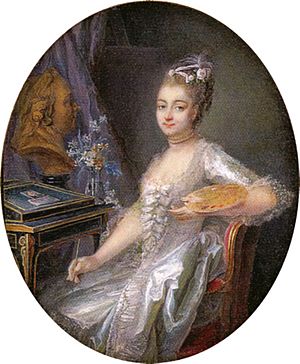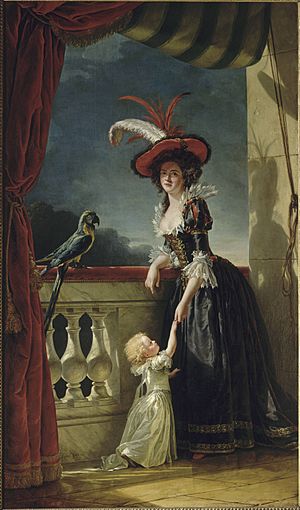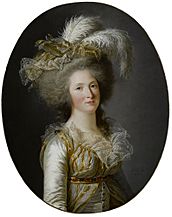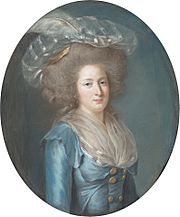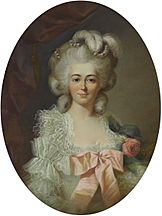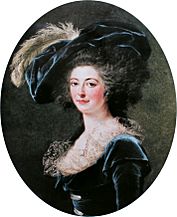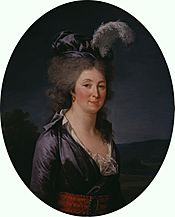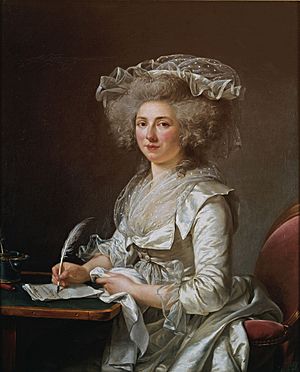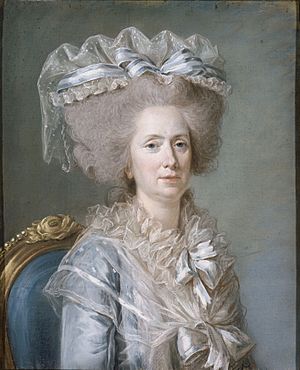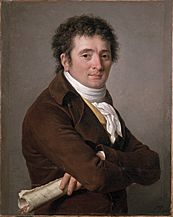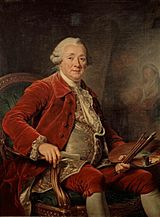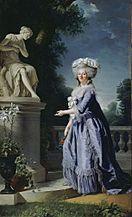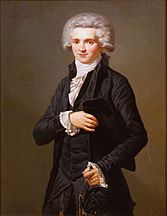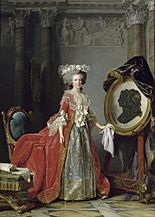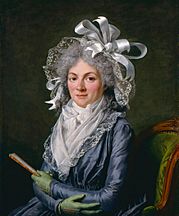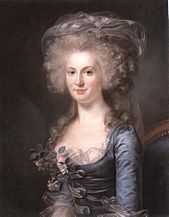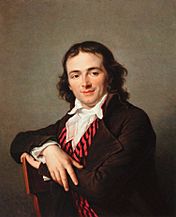Adélaïde Labille-Guiard facts for kids
Quick facts for kids
Adélaïde Labille-Guiard
|
|
|---|---|
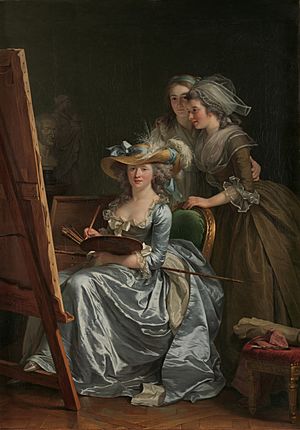
Self-Portrait with Two Pupils, by Adélaïde Labille-Guiard, 1785. The two students are Marie Capet and Marie-Marguerite Carreaux de Rosemond.
|
|
| Born |
Adélaïde Labille
11 April 1749 Paris, France
|
| Died | 24 April 1803 (aged 54) Paris, France
|
| Nationality | French |
| Known for | Miniatures, painting, pastels |
| Movement | Rococo to Neoclassicism |
| Spouse(s) |
Nicolas Guiard
(m. 1769, divorced)François-André Vincent
(m. 1799) |
Adélaïde Labille-Guiard (born Adélaïde Labille; April 11, 1749 – April 24, 1803) was a talented French artist. She was known for her miniature paintings and portraits. She strongly believed that women should have the same chances as men to become famous painters. Adélaïde was one of the first women to join the important Royal Academy of Painting and Sculpture. She was also the first female artist allowed to open a studio for her students at the Louvre museum.
Contents
Adélaïde's Art Training
Adélaïde Labille-Guiard became very skilled at painting miniatures, using pastels, and oil paints. We don't know much about her early training. In the 1700s, it was unusual for male art teachers to take on female students. People often thought women couldn't learn art as well as men.
When she was a teenager, Adélaïde studied miniature painting with an oil painter named François-Élie Vincent. Her first artworks were shown at the Académie de Saint-Luc. She also learned from a famous pastel artist, Quentin de la Tour, until 1774.
Her Amazing Achievements
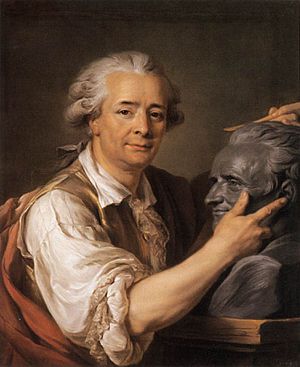
Showing Her Art at the Académie de Saint-Luc
Adélaïde Labille-Guiard joined the Académie de Saint-Luc in 1767 when she was 20 years old. The painting she submitted to get in has been lost. The Académie de Saint-Luc gave Adélaïde a place to work as a professional artist.
In 1774, she showed her art at their exhibition, called a Salon. Her show was so successful that the Royal Academy felt threatened. With the king's support, they closed down many art groups, including the Académie de Saint-Luc, in 1777. But this didn't stop Adélaïde from pursuing her dream of being an artist.
Joining the Royal Academy
After the Académie de Saint-Luc closed, Adélaïde started learning oil painting. To join the Royal Academy, artists had to present at least one oil painting. In 1779, she showed her work at another exhibition called the Salon de la Correspondance. She displayed her self-portrait in pastel and some oil portraits. Critics loved her work.
Adélaïde's talent in both oil and pastel painting was quickly noticed. She became famous across France. This led to her being accepted into the Royal Academy. On May 31, 1783, she officially became a member of the French Academie Royale de Peinture et de Sculpture. Her rival, Elisabeth-Louise Vigée Le Brun, also joined that day. Being accepted into the Royal Academy opened many doors for Adélaïde. She started getting support from the royal family.
Painter for the Royal Family
Because of her amazing artistic skill, Adélaïde Labille-Guiard became a painter for the French Royal family. Her royal clients included King Louis XVI's aunt, Princess Marie Adélaïde, and her sister Victoria Louise. She also painted the King's sister, Elizabeth. This earned her a yearly payment from the government.
Her portrait of Princess Adélaïde, finished in 1787, was one of her biggest and most challenging works. In 1788, the King's brother, the Count of Provence (who later became Louis XVIII), asked her to paint a large historical scene with him in the middle. In 1795, she was given a studio space at the Louvre museum. She also received a new, larger payment. She was the first female artist allowed to have a studio for herself and her students at the Louvre.
- Paris society portraits by Adélaïde Labille-Guiard
Her Unique Painting Style
Adélaïde Labille-Guiard's paintings often pushed the boundaries of what was considered proper for women in the 1700s. To appeal to many people, she often included the latest fashions in her paintings. This showed off her amazing artistic skill. She was very good at painting details, like the fancy folds and layers of the complex skirts that were popular then.
However, she often added a twist. For example, she would paint women looking directly at the viewer or with a slightly lower neckline. This was unusual for portraits of women at that time.
You can see Adélaïde's boldness in her self-portraits. In her painting Self-Portrait with Two Pupils, she shows herself actively working. Other female artists in the 1700s often painted themselves resting. Adélaïde also challenged rules that limited how many women could join the Royal Academy. By showing two female students in her self-portrait, she suggested that more women should be allowed into the Academy. Adélaïde was daring, but careful enough not to ruin her good reputation in the art world.
Helping Young Female Artists
Adélaïde Labille-Guiard had a big impact on her young female students. A mother whose daughter studied with a female academic (likely Adélaïde) wrote a letter. She explained that the teacher made sure her studio followed the highest standards of modesty.
Adélaïde's dedication to female students was clear throughout her time at the Royal Academy. At a meeting on September 23, 1790, she suggested that women should be allowed into the Academy without limits. She also proposed that women should be allowed to serve on the Academy's main board. Both of her ideas were approved!
Adélaïde During the Revolution
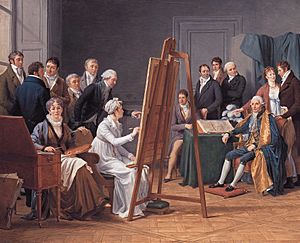
Adélaïde Labille-Guiard stayed in France during the French Revolution of 1789. However, her connections to the royal family made her a suspect. In 1793, she was told to destroy some of her paintings that showed support for the monarchy. This included an unfinished painting for the Count of Provence.
Because the Count of Provence had to leave France, Adélaïde lost her last royal client. She also never received the large payment she was promised for the painting. The Revolution further harmed her career when the royal sisters left France in February 1791. They didn't pay for several portraits they had asked Adélaïde to paint.
The pastel portraits of Marie Adélaïde, Victoire-Louise, and Élisabeth stayed with Adélaïde Labille-Guiard until she passed away from an illness on April 24, 1803.
Her Lasting Impact
You can find Adélaïde Labille-Guiard's artworks in many public collections. These include the Getty Museum, the Phoenix Art Museum, Harvard University Art Museums, the Honolulu Museum of Art, Kimbell Art Museum (Fort Worth, Texas), the Los Angeles County Museum of Art, the Louvre, the Metropolitan Museum of Art, the National Gallery of Art (Washington, D.C.), the National Museum in Warsaw, the National Museum of Women in the Arts (Washington, D.C.), the Speed Art Museum (Kentucky), and Versailles.
Adélaïde Labille-Guiard is also honored in Judy Chicago's famous art installation, The Dinner Party. Her name is on one of the 999 tiles of the Heritage Floor.
-
Madame de Genlis, 1780
-
Marie-Gabrielle Capet, 1785
See also
 In Spanish: Adélaïde Labille-Guiard para niños
In Spanish: Adélaïde Labille-Guiard para niños


